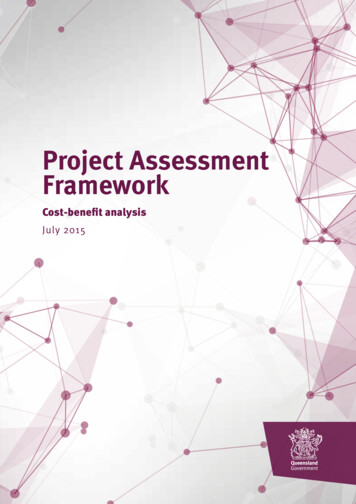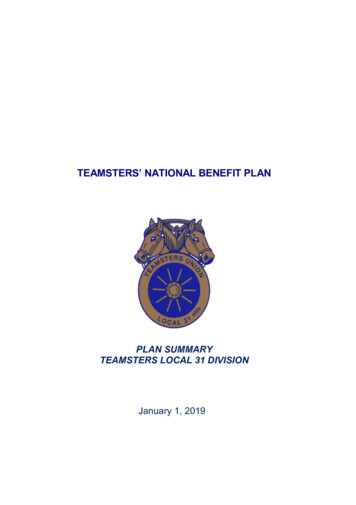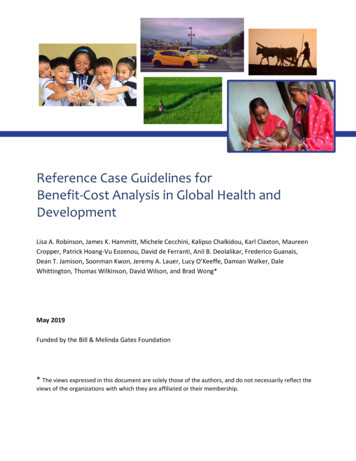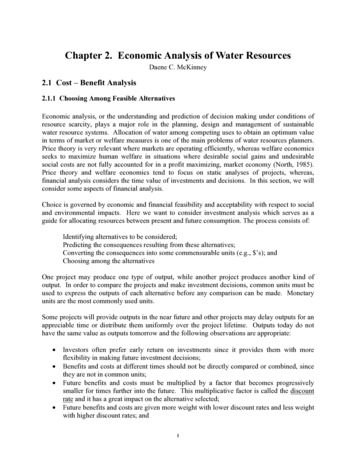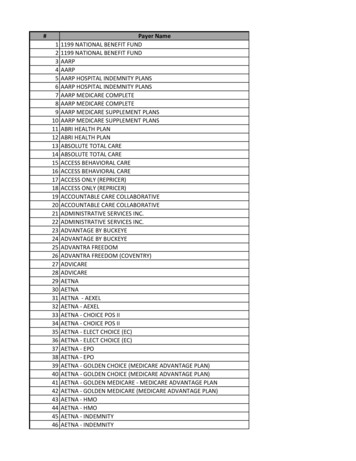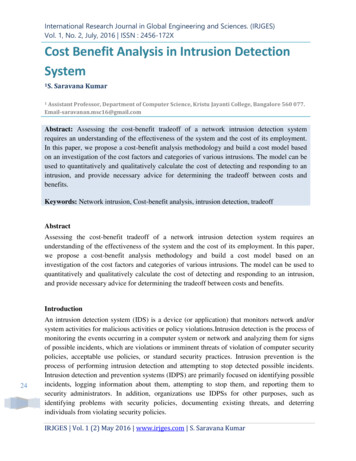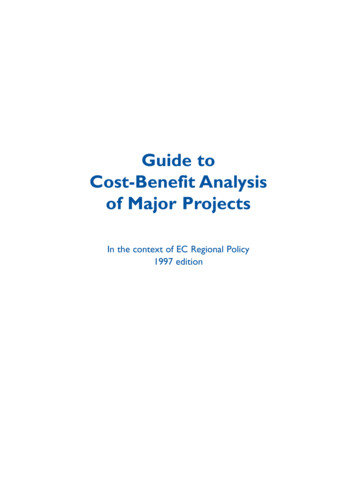
Transcription
Guide toCost-Benefit Analysisof Major ProjectsIn the context of EC Regional Policy1997 edition
Table of contentsIntroduction3Structure of the guide4SECTION ONEMajor projects in the framework of the Structural Funds and the Cohesion Fund1.1. Scope and objectives1.2 Definition of major projects1.3 Responsibility for prior appraisal1.4 Information required1.5 Reports and publicity56791112SECTION TWOAn agenda for the project examinerOverview2.1 Project identification2.2 Objectives2.3 Feasibility and option analysis2.4 Financial analysis2.5 Socio-economic costs2.6 Socio-economic benefits2.7 Discounting2.8 Economic rate of return2.9 Other evaluation criteria2.10 Sensitivity and risk151616171920212528283031SECTION THREEOutlines of project analysis by sectorOverview3.1 Energy transport and distribution3.2 Energy production3.3 Roads and highways3.4 Surface and underground railways3.5 Ports, airports and infrastructure networks3.6 Water supply, transport and distribution3.7 Sewers and depurators3.8 Refuse and waste treatment3.9 Training infrastructures3.10 Museums and archaeological parks3.11 Hospitals and other health infrastructures3.12 Forests and parks3.13 Telecommunications infrastructures3.14 Industrial estates and technological parks3.15 Industries and other productive investments3334343639414446495154565961646769
1APPENDICESA. Outline of an Appraisal ReportA.1 SummaryA.2 Socio-economic environmentA.3 Demand and supply of the project's outputsA.4 Technology options and production planA.5 Human ResourcesA.6 LocationA.7 ImplementationA.8 Financial analysisA.9 Socio-economic Cost-Benefit AnalysisA.10 Risk analysis7474747575767677777878B. Glossary79C. Reference by main sectors1.General2.Experience3.Energy4.Transport 10. Environment11. Education12. Tourism13. Health14. Forestry and agriculture15. Telecommunications16. Industrial CBACFCIFCost Benefit AnalysisCohesion FundCost, Insurance, FreightESFEUFIFGCSFDGEAGGFCommunity Support FrameworkDirectorate GeneralEuropean Agriculture Guidance andGuarantee FundEuropean CommissionEuropean Investment BankEconomic Net Present ValueEuropean Regional Development FundEconomic Rate of ReturnFNPVFOBFRREuropean Social FundEuropean UnionFinancial Instrument ofFisheries GuidanceFinancial Net Present ValueFree on BoardFinancial Rate of ReturnGDPIRRSFVATGross Domestic ProductInternal Rate of ReturnStructural FundsValue Added TaxECEIBENPVERDFERR
Nevertheless, most major projects share some commonkey-issues and their analyses should be expressed in acommon language.IntroductionThe analysis of the socio-economic costs and benefitsof major projects is explicitly requested by the new ECRegulations governing Structural Funds (SF). Such ananalysis is also required by the Cohesion Fund (CF)Regulation, regardless of the size of the project cofinanced. In the expectation that Member States willtake the responsibility for prior appraisal and providethe Commission with the relevant information, theCommission itself should in turn carefully assess thequality of such an appraisal.While this document does not provide strict guidelinesabout the preparation and the evaluation of majorprojects, it may help Commission officials indiscussing with their counterparts in Member Statesways of reducing costs and of improving the socioeconomic benefits of the projects. In some cases,Commission officials may use this agenda to suggest arevision of the project analysis. This revision workmay lead to a new project design or even to itsabandonment in favour of other more promisingprojects.This guideChecking for costs and benefits is a vehicle fordialogue among partners, between the Member Statesand the Commission, between project proposers,officials and consultants: an instrument for collectivedecision-making.This guide offers Commission officials, externalconsultants and any other interested parties, an agendafor the process of checking the appraisal of majorprojects under SF financing, including FIFG (FinancialInstrument of Fisheries Guidance) and CF. The text isspecifically designed for Commission officials, whoare not specialists in Cost-Benefit Analysis (CBA). Atthe same time, the text gives some indications toexternal experts, who may need to understand theCommission's specific needs for information on costsand benefits of proposed projects.In this respect, the guide is more about how to establishgood communications than about technicalities. Sometechnical issues may require some training or furtherreading as suggested in Annex C.Cost-Benefit Analysis. A procedure for evaluating thedesirability of a project by weighting benefits againstcosts. Results may be expressed in different ways,including internal rate of return, net present value andbenefit-cost ratio.A relatively short text such as this cannot cover all theaspects of CBA that a project examiner has to dealwith.There are important differences between investmentsin infrastructure and in productive sectors; there aregreat disparities among regions and countries, leadingto differences in crucial aspects of project appraisal;there are different theories, styles and shortcuts behinda number of practical approaches to CBA, as used bygovernment and private bodies.Cost-Benefit Analysis. A procedure for evaluating the desirability of a project by weighting benefits againstcosts. Results may be expressed in different ways, including internal rate of return, net present value andbenefit-cost ratio.3
Appendix A contains some additional tools that mayhelp practical work. This includes a comprehensivecheck-list for a typical Project Appraisal Report.Structure of the guideThe guide is in Three Sections. The First Section givesan overview of the appraisal of major projects under SFassistance and of projects financed by the CF.Appendix B is a Glossary which may help the readerwho is less familiar with the jargon of project appraisal.For the reader's convenience, Glossary items andexamples are also to be found in boxes in the main text.The Second Section is a structured path leading to theassessment of the quality of CBA. No pretence is madeof providing a systematic introductory text, nor is thispossible in such a short space. However, the guideoffers a presentation of the key-issues in the projectappraisal.Appendix C is a structured bibliography by sector(transport, agriculture, energy, etc.) and it gives a veryselective list of state-of-the-art manuals and otherreading material that may set a standard of quality forCBA of major projects under SF financing.The Third Section offers some useful materialconcerning major projects in specific sectors ofrelevance for EC regional and cohesion policies.Each chapter in this section is about a crucial item onthe agenda of a project examiner, and we recommendseeing it as a sequence of checks and controls to betried, rather than as chapters of a manual to be read.References to appropriate text-books are provided forsome technical aspects of CBA.A reference text for Structural Funds and Cohesion Fund is:European Commission, Structural Funds and Cohesion Fund 1994-99, Regulations and Commentary,Brussels, 1996.A series of seven handbooks on methods for evaluating actions of a structural nature have been prepared bythe Centre for European Evaluation Expertise (Lyon) in the context of Means programme, on behalf ofEuropean Commission DG XVI/G2, Coordination of Evaluation.A broad assessment of the impact of European Regional Policies is: European Commission, first report onEconomic and Social Cohesion, preliminary edition, Brussels, 19964
Section OneMajor projects in theframework of theStructural Funds andthe Cohesion Fund5
1.1. Scope and objectivessecond generations” of reformed Structural Funds andby the Cohesion Fund. Table 1 gives the distribution bysector of a survey of 200 major projects co-financed bySF between 1989-93. Table 2 gives the same kind ofinformation for a sample of 200 major projectsfinanced by ERDF for the period 1994-99 and by CFbetween 1993-96. Elsewhere we shall consider datadrawn from the cumulative sample of 400 projects.Major projects co-financed by Structural Funds are animportant part of the implementation of EC regionalpolicy. They are explicitly mentioned in differentarticles of SF Regulations where it is understood thatmajor projects may be either a component ofoperational programmes or individual actions. Thesuccess or failure of major projects may have a crucialimpact on the whole EC regional policy in somecountries, and this justifies a careful appraisal.EU Structural Funds may support a very wide range ofprojects, both in terms of sectors involved and in termsof size of investment.The need to assess the socio-economic costs andbenefits of major projects is also mentioned in differentarticles of the Structural Funds Regulations.While the CF exclusively finances projects in thetransport and environment sectors, the SF, and theERDF in particular, may also support projects in theenergy, industry and service sectors. The scope of SFactivities includes agriculture, fisheries and waterculture if we also consider the European AgriculturalGuidance and Guarantee Fund (EAGGF) and theFinancial Instrument of Fisheries and Guidance(FIFG).Under these Regulations both infrastructure andproductive investments may be co-financed by one ormore Community financial instruments: grantinstruments (Structural Funds, Financial Instrument ofFisheries Guidance and Cohesion Fund) and loan orguarantee instruments (European Investment Bank,European Investment Fund, Financial Mechanism ofthe European Economic Area, etc.).Since, in principle, for projects related to theenvironment and to infrastructure linked to transEuropean transport networks, there could be someoverlapping of grant instruments (CF, on the one hand;ERDF and, to a certain extent, also the EAGGF,Guidance Section on the other), Art. 9 (1) of the CFRegulation states that no item of expenditure of thesame project may benefit both from the Cohesion Fundand from one of the Structural Funds. This does nothowever mean that different phases of the same majorproject may not be financed separately by the CF andby the SF. Anyway, the same Article permits assistancefrom the CF to be combined with that from otherfinancial instruments, such as those set up under the EUtransport and environment policies, provided that totalCommunity support granted to a project does notexceed 90% of total and related costs. Either CF or SFsupport may be combined with loan instruments suchas EIB financing.This guide was specifically designed for the process ofappraisal of projects co-financed by grant instruments.Obviously, this does not mean that it cannot also beapplied to projects co-financed by other instruments,especially as the same project may in many casesbenefit from financial contributions which combinegrants and loans (Art. 5 (4) of Reg. 2081/93).It should be pointed out that when the guide mentionsStructural Funds in general, this also implicitlyincludes the Financial Instrument of FisheriesGuidance (FIFG), since this is also subject to theprovisions of the Framework Regulation (Reg.2081/93) and the Coordination Regulation (Reg.2082/93) of SF.The CF finances projects that, for the specific purposesof this guide, may in many respects be similar to themajor projects under SF assistance. Similar treatment isfurther justified by the fact that Art. 10 (5) of theCouncil Regulation (EC) No 1164/94 establishing theCohesion Fund explicitly requests an appraisal of “themedium-term economic and social benefits (ofprojects), which shall be commensurate with theresources deployed” and states that “an assessmentshall be made in the light of a Cost-Benefit Analysis”.A good appraisal of the investment decisions in such awide range of sectors may improve their success rateand thus strengthen development opportunities in thegeneral framework of regional and cohesion policies. Itis then important to learn from past experience and topromote a better appraisal. First comes the question:what should we consider a major project for thepurpose of socio-economic appraisal? Then: what kindof appraisal does the Commission need for such majorprojects?There is already a wealth of experience on majorinvestment projects implemented by the “first and6
were considered in the survey. Once again the new sample isnot necessarily representative of the composition of thelarger number of major projects co-financed by SF and CF inthe period concerned.Table 1. Composition of the ‘first generation’ ofmajor projects by sector. SF 1989-93 *No.EnergyWater and environmentTransportIndustryOther .2 Definition of majorprojectsAs far as the SF are concerned, Art. 16 (2) of CouncilRegulation 2082/93 (Coordination of Structural Funds)defines major projects as “those the total cost of whichtaken into account in determining the amount ofCommunity assistance is, as a general rule, greater thanECU 25 million for infrastructure investments orgreater than ECU 15 million for productiveinvestments”.* The table is based on an ad hoc survey carried out in 1994by a working team of the Evaluation Unit, DG XVI RegionalPolicy. It is not necessarily representative of the compositionof the larger number of major projects co-financed by SF in theperiod 1989-93.For such major projects the proposer is required toprepare an in-depth socio-economic appraisal and togive the Commission detailed information on itsresults. Obviously, the Commission expects that anappropriate investment appraisal be done by proposersfor smaller projects as well, but normally theCommission will focus on the evaluation ofprogrammes and of major projects. The requirement ofdetailed information on the appraisal of major projectsis strictly binding both when they are part of a widerprogramme, or when individual projects are proposedto the Commission for co-financing.Table 2. Composition of the ‘second generation’ ofmajor projects by sector. ERDF 1994-99 and CF1993-96 *No.EnergyWater and environmentTransportIndustryOther he above mentioned limits of 25 million ECU forinfrastructure and 15 million ECU for productiveinvestments are to be understood as follows:* In 1996, the Evaluation Unit carried out a new survey of asample of 200 major projects. In addition to the secondgeneration of projects co-financed by the ERDF (1994-99),the analysis was extended to projects co-financed by the CFsince its temporary establishment in 1993 (as “CohesionFinancial Instrument”). Although CF projects generally carryan investment cost of at least 10 million ECU, for ease ofcomparison with projects co-financed by ERDF, only CFprojects with a minimum investment cost of 25 million ECUa)the relevant economic dimension is the totalamount of investment costs. In order to assess thisfigure, one ought not to consider sources offinance (e.g. public sector finance only, or the ECco-financing only) but the overall economic valueThe following list gives some examples of the sectors supported by the ERDF, which is the SF most frequentlyinvolved in part-financing of suitable projects.Transport. Railways, airports, roads and highways, ports, underground, trans-European networks (Objective 1Regions)Water and environment. Aqueducts, dams and irrigation; depurators, waste treatment plants and otherenvironmental worksEnergy. Energy production, energy distribution, trans-European networks (Objective 1 Regions)Other services. Health and education (Objective 1 Regions), culture, arts, telecommunications (includingtrans-European networks for Objective 1 Regions), tourism, research and technological development, and otherservices to enterprisesIndustry. Productive investments, infrastructure7
Major projects, as defined above, may be financed, inprinciple, by different Structural Funds and by FIFG(see Art. 5, Reg. 2081/93), by the Cohesion Fund andby other means of assistance.of the proposed infrastructure or of the productiveinvestment;b) if investment costs are expected to be incurred overdifferent years, one has to consider their sumacross the years;c)As far as the CF is concerned, support is exclusively inthe form of financing of projects, stages of a project orgroups of projects (see Art. 1, Reg. 1164/94). Art. 10(3) of Council Regulation 1164/94 establishing theFund states that “Projects, including groups of relatedprojects, shall be of a sufficient scale to have asignificant impact in the field of environmentalprotection or in the improvement of trans-Europeantransport infrastructure networks. In any event, thetotal cost of projects or groups of projects may inprinciple not be less than ECU 10 million”, with dulyjustified exceptions.while one has to consider investment costs only,excluding running costs, it is advisable also toinclude in the calculation of total investment costany once-for-all expenditure such as recruitmentand training costs, licences, preliminary studies,design and other technical studies, pricecontingencies, allocation for net working capital,etc.;d) in some cases a group of small projects is sointerwoven that it is better understood as one largeproject (e.g. five sections of the same highway,each section at a cost of 6 million ECU, should betreated as a major project of 30 million ECU).For such significant projects, whatever the size, theproposer is required to prepare a Cost-Benefit Analysis,including the direct and indirect effects onThe CF finances projects in the fields of the environment (aqueducts, dams and irrigation; depurators, refuseand waste treatment plants and other environmental works, including reforestation, erosion control, natureconservation, beach resetting, etc.) and trans-European transport infrastructure networks (railways, airports,roads and highways, ports) in Member States with a per-capita GNP of less than 90% of the Community averageand with a programme leading to the fulfilment of the conditions of economic convergence as set out in Art.104c of the EU Treaty (Greece, Ireland, Portugal and Spain).The EAGGF (Guidance Section) and the FIFG may participate in the co-financing of investment projects inthe agricultural, forestry and silviculture sectors, and the fishing and water-culture sectors, respectively. In thecase of less developed Regions, the EAGGF may also finances projects in the fields of environment, energy,roads, irrigation and other water related programmes, as well as investments in the tourism and craft sectors.The kind of projects co-financed by the ESF (vocational training and employment incentives) are not coveredby this guide, due to their specific nature.Art. 5, Reg. 2081/93 (SF Framework Regulation). Forms of assistance“1. Financial assistance under the Structural Funds, from the EIB and the other existing Community financialinstruments shall be provided in a variety of forms that reflect the nature of the operations. 2. In the case ofthe Structural Funds and the FIFG, financial assistance may be provided principally in one of the following forms:(a) part-financing of operational programmes; (d) part-financing of suitable projects; ( )”This guide concerns both major individual projects and those which are a part of an operational programme.Art. 1, Reg. 1164/94 (Regulation establishing the CF). Definition and objective“3. The (Cohesion) Fund may contribute to the financing of:- projects, or- stages of a project which are technically and financially independent, or- groups of projects linked to a visible strategy which form a coherent whole.”As in the case of SF, CF assistance may also be granted for preliminary studies related to eligible projects andtechnical support measures, including those undertaken at the Commission's initiative.8
employment, possibly integrated with other evaluationmethods, in the case of projects in the environmentalfield.1.3 Responsibility for priorappraisalIt is clear that the considerations listed above foridentifying major projects under SF assistance (seepoints a) to d) above) are also pertinent in the case ofprojects financed by CF.The regulations governing the SF and the CF bothestablish similar responsibilities for the prior appraisalof investment projects. Our analysis below will bebased on the more general norms of the SF, while thecorresponding provisions of the CF Regulationgoverning responsibility for project appraisal will beshown in boxes.According to Art. 14 of Reg. 2082/93 “Applicationsshall contain the information the Commission needs inorder to assess them”. The responsibility for appraisaland evaluation of major projects is, as for any otheraspect of SF implementation, a joint-venture betweenthe Commission and the Member States. Art. 26 ofReg. 2082/93 states “Appraisal and evaluation shall bethe responsibility both of the Member States and theCommission and be carried out within the frameworkof the partnership”. The appraisal must show “mediumterm economic and social benefits commensurate withresources deployed”.Art. 26 (3) states that “in vetting individualapplications for assistance, the Commission shall takeinto account the findings of appraisal and evaluation”.Art. 26, Reg. 2082/93 (SF Coordination Regulation). Appraisal and evaluation“1. appraisal and evaluation shall be the responsibility both of the Member States and the Commission and becarried out within the framework of the partnership. The competent authorities in the Member States shallcontribute in such a way as to ensure that this appraisal and evaluation can be carried out in the most effectivemanner. In this connection, appraisal and evaluation shall make use of the various particulars that themonitoring arrangements can yield in order to gauge the socio-economic impact of the operations, whereappropriate in close association with the monitoring committees.Assistance will be allocated where appraisal shows medium-term economic and social benefits commensuratewith the resources deployed ( ).”Art. 13, Reg. 1164/94 (Regulation establishing the CF). Appraisal, monitoring and evaluation“2. In order to ensure the effectiveness of Community assistance, the Commission and the beneficiary MemberStates shall, in co-operation with the EIB where appropriate, carry out a systematic appraisal and evaluation ofprojects.3. On receipt of a request for assistance and before approving a project, the Commission shall carry out athorough appraisal in order to assess the project's consistency with the criteria laid down in Art. 10 (5)(medium-term economic and social benefits shall be commensurate with the resources deployed). TheCommission shall invite the EIB to contribute to the assessment of projects as necessary”.“5. In vetting individual applications for assistance, the Commission shall take into account the findings ofappraisals and evaluation made in accordance with this Article”.9
Member States often have their own internal structuresand procedures for the evaluation of large projects, butin some cases there may be difficulties in theimplementation of quality appraisal. The Commissionmay help to overcome these difficulties in differentways. Technical assistance in the preparation of projectappraisal may be co-financed in the context of therelevant Community Support Framework.It is therefore clear that Commission decisions onmajor projects must be based on in-depth appraisal, inthe first instance by proposers. When the appraisalpresented by the proposer is not deemed sufficient andconvincing, the Commission may ask the proposer fora revision or an extension of the analysis, or theCommission may also prepare a project appraisalexercise of its own, and - when necessary - ask forindependent evaluation. In this respect, in the specificcase of the Cohesion Fund, the regulation states that theCommission may avail itself of the assistance of theEuropean Investment Bank in the evaluation ofprojects, where appropriate. In practice, recourse to theexpertise of the EIB is most common in the case oflarger projects, regardless of whether or not they areco-financed by the EIB itself.The proposer is advised to ask the Commission servicesfor any information he/she needs about these aspects.In principle there is no lack of means for an appropriateappraisal of projects: the Commission asks MemberStates to perform such a task, difficult as it may be, butalso offers financial and technical help for its betterimplementation.In any case, the Commission decision will be theoutcome of a dialogue and of a joint-effort with theproposer, in order to achieve the best investmentresults.Art. 14, Reg. 2082/93 (SF Coordination Regulation). Processing of applications for assistance“2. Applications shall contain the information the Commission needs in order to assess them where this is notalready included in the plans, including a description of the proposed measure, its scope, including geographicalcoverage, and specific objectives. Applications shall also include the results of prior appraisal of the mediumterm economic and social benefits of the proposed measures commensurate with the resources to bedeployed, the bodies responsible for implementation, the proposed beneficiaries and the proposed timetableand financing plan, together with any other information necessary to verify that the measure concerned iscompatible with Community legislation and policies”.Art. 10, Reg. 1164/94 (Regulation establishing the CF). Approval of projects“4. Applications shall contain the following information: the body responsible for implementation, the natureof the investment and a description thereof, its costs and location, including, where applicable, an indication ofprojects of common interest situated on the same transport axis, the timetable for implementation of thework, a Cost-Benefit Analysis including the direct and indirect effects on employment, information enablingpossible impact on the environment to be assessed, information on public contracts, the financing planincluding, where possible, information on the economic viability of the project, and the total financing theMember State is seeking from the Fund and any other Community sources. They shall also contain all relevantinformation providing the required proof that the projects comply with the Regulation and with the criteriaset out in paragraph 5, and particularly that there are medium-term economic and social benefitscommensurate with the resources deployed.5. The following criteria shall be applied to ensure the high quality of projects:- their medium-term economic and social benefits, which shall be commensurate with the resourcesdeployed; an assessment shall be made in the light of a Cost-Benefit Analysis,- ( )- the contribution which projects can make to the implementation of Community policies on theenvironment and trans-European networks,- ( )6. the Commission shall decide on the grant of assistance from the Fund provided that the requirements ofthis Article are fulfilled, ( )”10
must provide additional information, besides thatspecified in Art. 14 of Reg. 2082/93. Whilst this can besent to the Commission at a “later date” when theproject is part of an operational programme, forindividual projects such additional information must beconsidered as an essential part of the application. Forinvestments in infrastructure, an “analysis of costs andsocio-economic benefits of the project” is in theforefront of the information requirements. Forproductive investments market outlook, profitabilityand employment are the criteria mentioned.1.4 Information requiredWhilst establishing that projects requesting supportfrom the Fund must contain an adequate socioeconomic appraisal, the CF regulation also gives someindications of the evaluation methods that can be used:a Cost-Benefit Analysis integrated, in the case ofprojects related to the environment, with otherevaluation methods possibly of a quantitative type suchas multi-criteria analysis (see Art. 10(5), Reg.1164/94, and Statements added to Council minutes).Other information that applications for CF assistanceshould contain are: an appraisal of the direct andindirect effects on employment; an indication of thecontribution of the project to the EC environmentpolicy or trans-European networks policy; a “financingplan including, where possible, information on theeconomic viability of the project” (see Art. 10 (4), Reg.1164/94).A project examiner should consider these and similarlists in legislation more as a general indication ofinformation requirements rather than a rigid set ofcriteria. In some cases, external social benefits andcosts may also be important also in productiveinvestment projects, and it would be a mistake todisregard them.In the case of the SF, the ERDF regulation givesindication of the evaluation methods that should beemployed. Art. 5 of Reg. 2083/93 states thatapplications to ERDF concerning both individualprojects and those within an operational programme,On the other hand, even when infrastructure projectsfinanced by the public sector are considered, it isadvisable to conduct a financial analysis. As we shallexplain in the second section of the guide, it isparticularly important to understand to what extent,Art. 5, Reg. 2083/93 (ERDF Regulation). Projects“In addition to the information specified in Article 16 of Regulation (EEC) No 4253/88, applications for ERDFassistance for the projects referred to in Article 5 (2) (d) of Regulation (EEC) No 2052/88 submittedindividually or within the framework of an operational programme shall provide the information set out below.However, in the case of projects forming part of an operational programme, the information may be sent tothe Commission at a later date.”The information shall cover:(a) for investment in infrastructure:- analysis of the costs and socio-economic benefits of the project, including a
A.2 Socio-economic environment 74 A.3 Demand and supply of the project's outputs 75 A.4 Technology options and production plan 75 A.5 Human Resources 76 A.6 Location 76 A.7 Implementation 77 A.8 Financial analysis 77 A.9 Socio-economic Cost-Benefit Analysis 78 A.10 Risk analysis 78 B.Glossary 79 C.Reference by main sectors 81 1. General 81 2 .
